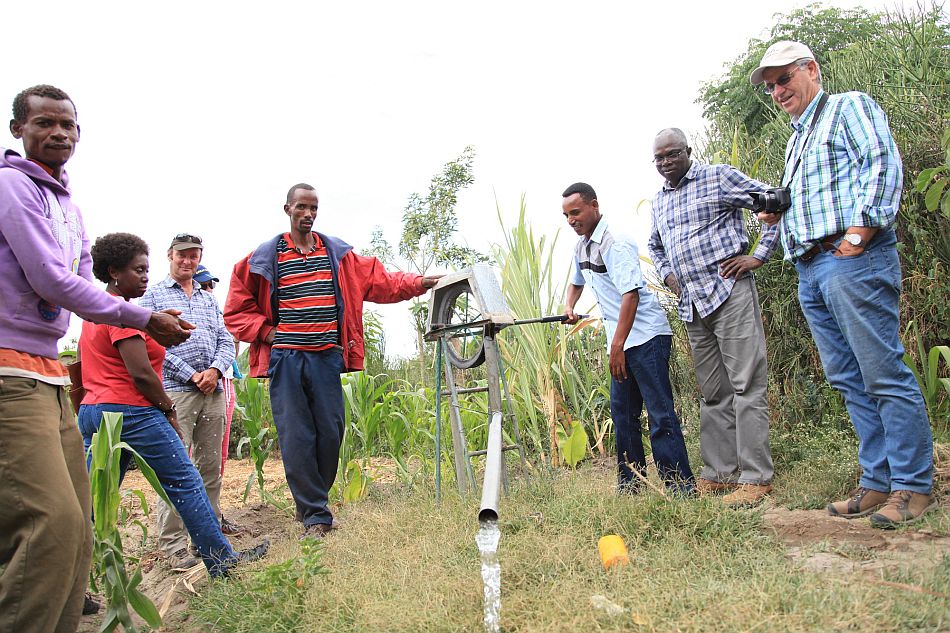New IWMI findings suggest that adaptive management, a structured approach to decision-making in the face of uncertainty, can help achieve sustainable agricultural transformation.
By Amare Haileslassie, Principal Researcher, IWMI

Photo: Apollo Habtamu / IWMI
Ethiopia has decades of experience in implementing land and water management interventions. However, the resulting alteration of agricultural landscapes along with widespread land degradation are causing considerable negative environmental and economic impacts. By one estimate, the net cost of land degradation due to land use and land cover changes is about USD 4.3 billion annually.
Sustainably transforming and restoring Ethiopia’s agricultural landscapes requires addressing the drivers of land degradation while maintaining or increasing ecosystem services, such as provision of food and water.
Doing so would also play an important role in reducing poverty. According to the World Bank, every 1% growth in gross domestic product would result in a 0.15% reduction in poverty. Economic growth in the agricultural sector would make an even greater contribution, with every 1% increase in agricultural output reducing poverty by 0.9%.
A recent report, Shining a Brighter Light: Comprehensive Evidence on Adoption and Diffusion of CGIAR-related Innovations in Ethiopia, showed that an estimated 9.4 million rural households had adopted innovative soil and water conservation practices linked to research conducted by IWMI and other CGIAR centers. What can we learn from these investments and the impact of land and water management interventions on agricultural landscapes?
New IWMI findings published in the journal of Sustainability suggest that adaptive management, a structured approach to decision-making in the face of uncertainty, can help achieve sustainable agricultural landscape transformation. As uncertainties – climate change, diseases, natural disasters and market shocks – are inherent to agriculture, the approach holds significant potential.
The concept of adaptive management is centered around iterative learning about a system and making management decisions based on that learning. The adaptive process is often represented as a cycle of ‘plan, do, monitor and learn’.
What makes adaptive management distinct from the traditional trial-and-error approach is that it involves exploring alternative ways to meet management objectives. It forecasts the outcomes of alternatives based on the current state of scientific knowledge and implements one or more of these alternatives. Adaptive management monitors the impacts of management actions, updates knowledge and adjusts management decisions accordingly.
Overcoming bottlenecks in agricultural water management
The main objectives of the IWMI study were to synthesize evidence on the impact of land and water management interventions on agricultural landscapes in Ethiopia and to evaluate the use of adaptive management approaches as a tool to manage uncertainties. The researchers considered evidence at different scales (farm plots, watersheds, landscapes and basins) and consolidated the implications at the national scale.
An analytical framework was developed that matched target indicators with key elements of the adaptive management approach. For each of the selected indicators, the researchers looked at whether the evidence reviewed attributed the failure or success of the interventions to one or more elements of the adaptive management approach. Although the study focused on Ethiopia, the analytical framework can be applied to other countries and regions.
Several aspects of land use and land cover changes were examined, including expansion of cultivated land, soil conservation measures and small water harvesting structures. In the case of the latter, many national and regional governments have encouraged the introduction of water harvesting structures such as farm ponds and micro dams to improve livelihoods and adapt to climate change. However, the impacts of these structures have been limited by siltation, seepage losses, insufficient flows, structural damage and spillway erosion. In addition, too little focus on inclusion means that in many cases wealthier farmers have benefited more than poor farmers.
As a result, many interventions related to small water harvesting structures have not met farmers’ expectations. In several cases, farmers stopped using them altogether. The IWMI study argues that enabling adaptive management is a good starting point to overcome some of these bottlenecks. This is because adaptive management demands early community engagement, understanding trade-offs, monitoring changes and impacts, and learning from them. If tailored to the local context, the approach could mitigate the negative environmental, economic and social consequences of small water harvesting interventions currently observed.
More broadly, the study concludes that planning and implementation of interventions to sustainably transform agricultural landscapes need structured decision support and continuous learning tools. These are currently limited in Ethiopia and other countries in sub-Saharan Africa. Yet while adaptive management is useful for natural resource decision-making, it is not an end in itself. Rather, success depends, among other things, on how adaptive management is tailored to context and the ability to learn from the knowledge generated and apply the learning as implementation progresses.

